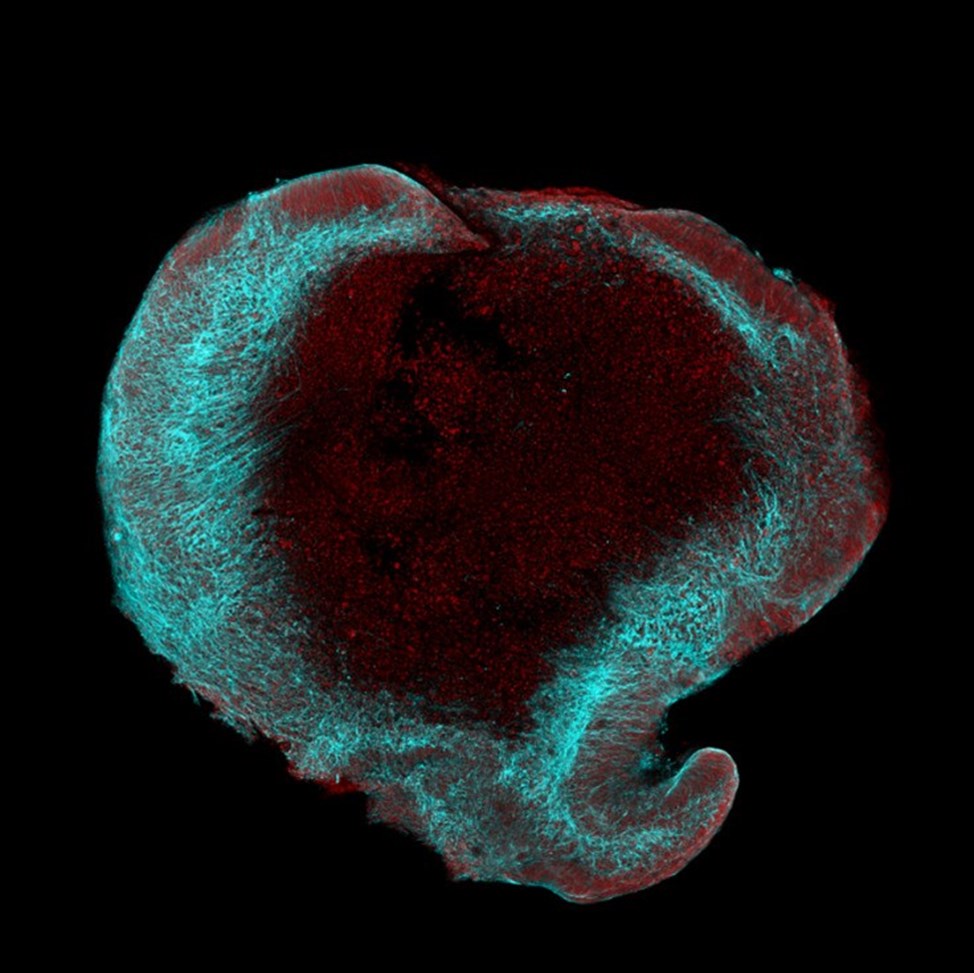Brno scientists get closer to the future treatment of Alzheimer’s disease
A team of 23 scientists from Brno has come significantly closer to answering the question of how to prevent and treat Alzheimer’s disease, which is the most common cause of dementia and leads to gradual dependence on the daily help of another person. Experts from the Faculties of Science and Medicine at Masaryk University, the International Clinical Research Center and the Masaryk Memorial Cancer Institute believe that the results of the research will help develop other highly effective therapeutic agents for this 21st century threat to civilisation.

Photo: Microscopic image of a brain organoid
“A key role in the development of Alzheimer’s dementia is played by apolipoprotein E (ApoE), which is also found in brain tissue. We have discovered the molecular basis of the undesirable accumulation of this apolipoprotein and at the same time shown a way to suppress this accumulation of ApoE with a potential drug that is already in advanced clinical testing with expected approval in 2025,” as a molecular biologist Martin Marek summarised the main significance of the research. Martin Marek works in the Loschmidt laboratories of the RECETOX Centre at the Faculty of Science of Masaryk University and at the International Clinical Research Centre (ICRC), which is a joint workplace of St. Anne’s University Hospital Brno and the Faculty of Medicine of Masaryk University.
ApoE plays an important role in the functioning of the brain and its anti-inflammatory effect is also known. However, three variants are widespread in the human population: ApoE2, ApoE3 and ApoE4. The presence of the ApoE4 variant has previously been shown to be a major risk factor for the development of Alzheimer’s disease. In fact, inheritance of the ApoE4 variant significantly increases the risk of Alzheimer’s dementia. Patients with two copies of the ApoE4 gene have greater memory impairment, reduced ability to perform normal daily activities and more severe atrophy of brain tissue. Scientists from all over the world have been trying to unravel the mystery of ApoE4 for several decades, but it is only now that Brno scientists have taken a peek under the hood of this molecular mystery.
“The exciting thing about this research was that the toxic variant of ApoE4 differs from its non-toxic counterparts by only one mutation, which has huge implications for the behaviour of the protein and its relationship to the development of Alzheimer’s dementia,” explained Marek.
An important part of the study was to investigate how to prevent the unwanted deposition of ApoE4 in brain tissue and thus restore its important cellular functions. In layman’s terms – how to prevent or slow the development of the disease and preserve thinking and memory. In follow-up biochemical experiments, the researchers have shown that there is a substance called homotaurine, an amino acid derivative found in certain species of seaweed, which suppresses unwanted accumulation and restores the original functions in the ApoE4 protein, and could thus have a “therapeutic” effect in clinical practice.
For the experiments, the researchers used brain organoids, which are “mini-brains” grown in a test tube from the cells of Alzheimer’s patients. “We used brain organoids in this study to test the effect of homotaurine on the development of Alzheimer’s dementia. Our results confirm that the drug has a positive effect on organoids with the ApoE4 variant, and it appears to affect not only important signalling pathways but also cholesterol metabolism. In future studies, we want to focus on detailed mapping of the changes that homotaurine causes in the human brain,” outlined the future therapeutic effect of homotaurine and the future direction of research by cell biologist Dáša Bohačiaková from the Institute of Histology and Embryology at the MU Faculty of Medicine.
The Brno scientists managed to map the structural changes in the ApoE protein at the atomic level in detail by combining experimental and computational experiments. Due to these changes, the ApoE4 protein variant is not stable, has a high tendency to accumulate undesirably in brain tissue and thus loses its primary role in lipid and cholesterol transport.
“Dynamic changes in the structures of ApoE3 and ApoE4 proteins and their interactions with a potential drug (homotaurine) were studied using a unique hydrogen-deuterium exchange method coupled to mass spectrometry. The results revealed a structural rearrangement in ApoE4 causing aggregation, which was not observed in ApoE3. On the contrary, the interaction with the drug stabilized the structure of ApoE4 and thus suppressed its negative properties,” added biochemist Lenka Hernychová from the RECAMO centre of the Masaryk Cancer Institute.
The Brno scientists published the results of their research in the prestigious journal Molecular Neurodegeneration. The research was supported by the Ministry of Education and Science within the ENOCH and INBIO projects. The research was also financially supported by the European Union within the Horizon Europe programme through TEAMING and ADDIT-CE grants.
“The study was unique because it was able to complement classical molecular and cell biology methods with data obtained by mass spectrometry techniques. In this way, changes in protein and lipid levels can be monitored very sensitively and accurately and insights into the mechanism of action of potential drugs can be gained. At the same time, mass spectrometry can be used to characterise often heterogeneous cellular model systems,” said Zdeněk Spáčil, an analytical chemist from the RECETOX Centre at the Faculty of Science of Masaryk University.
Author: text and photo Masaryk University
Contact for media:
- Martin Marek, RECETOX, Faculty of Science MU and the ICRC – a joint workplace of FNUSA and MUNI MED – marek@recetox.muni.cz
- Šárka Nevolová, LL, Faculty of Science MU and ICRC, +420 723 886 646, nevolova@fnusa.cz
- Jiří Erlebach, Head of PR and Marketing Department, Spokesperson of FNUSA, +420 543 182 006. erlebach@fnusa.cz.
- Lenka Hernychová, Masaryk Memorial Cancer Institute – hernychova@mou.cz
- Dáša Bohačiaková, the Institute of Histology and Embryology of MUNI MED – bohaciakova@med.muni.cz
- Zdeněk Spáčil, RECETOX, Faculty of Science MU – spacil@recetox.muni.cz

